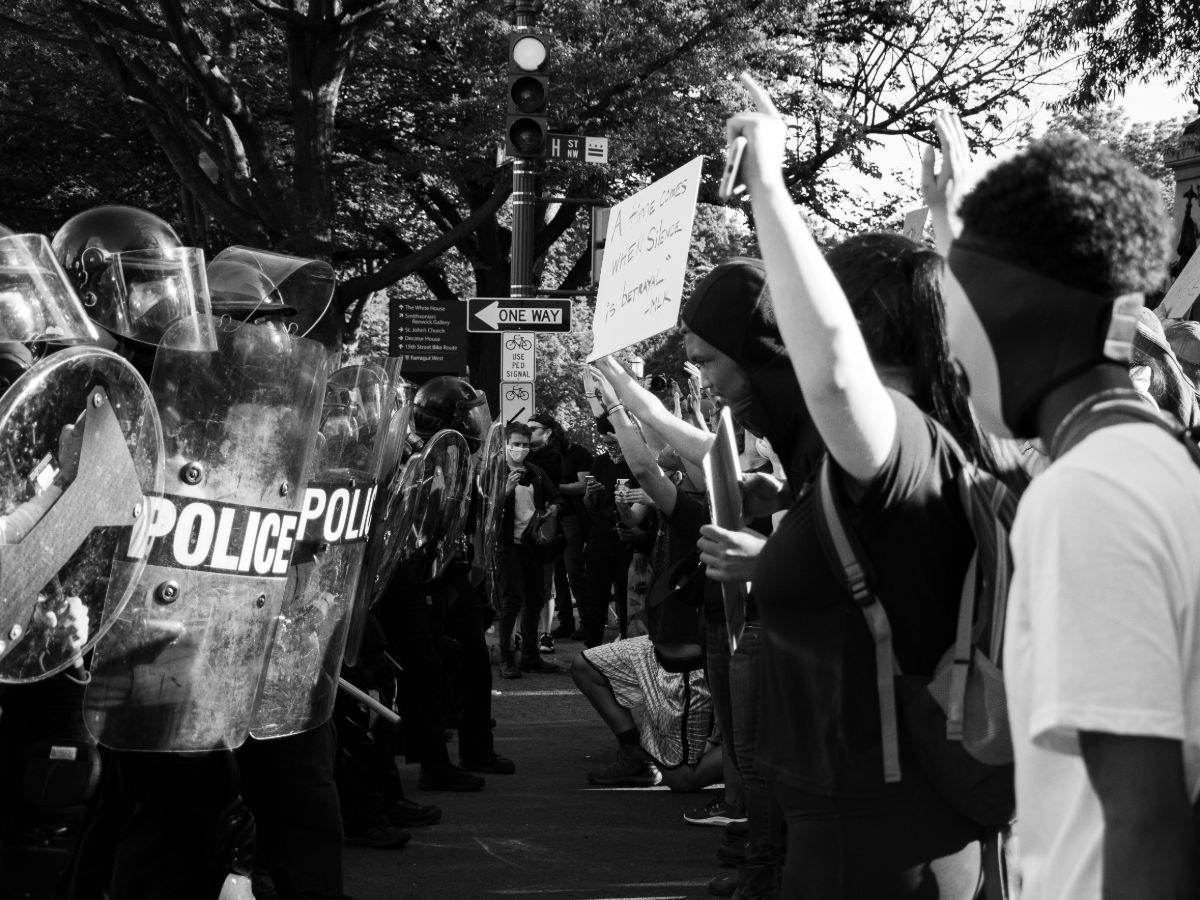
Providing for equality is easier said than done, and this is also reflected in social reality (→ Discrimination). Neither is it easy to determine how to treat people equally nor to determine whether someone stands in a comparable position (which entitles them to be treated equally). The principle of equality holds that people are by nature “equal” beings in the sense of holding the same fundamental rights. At the same time, it also recognises that people are not all “the same”, but rather very different individual human beings. How equality works in practice therefore depends on each individual’s concrete social context.
Thus, formal equality must be distinguished from substantive equality. For example: every student in Munich is instructed in German. This applies to the entire course of study. In this sense, they are all formally treated equally. But is there actual, tangible equality? Not when the cultural background of the students is considered, in which case we see that German-language instruction means different things for different students. For the vast majority of children residing in Munich, German instruction in the classroom means instruction in their first language. For those speaking a language other than German at home, German-language instruction means having lessons in a second or foreign language. A substantive view of equality would require first-language instruction to every pupil.
Naturally, this is not to say that all people must be treated substantively the same in every situation, which would be impossible. What is important is the insight that in many cases, a purely formal view of equality is inadequate and misses the mark. One example is the integration of Muslim populations which, in the “cultural shadow” of our Western legal systems, find themselves treated differently in many areas of life than the majority populations, whose cultures have developed together with these legal systems over time (→ Veil). The insight that a dictate of (substantive) equality of treatment can result in actual (formal) inequality is, of course, nothing new. As early as Aristotle, it was recognised not only that equivalent situations be treated the same, but that non-equivalent situations call for unequal treatment (→ Judiciary). This is also known as the paradox of the equality principle. Of course it is hardly paradoxical. Rather, it is only logical that equality in the legal sense is concerned with the actual comparability of real-life situations in order to take equality seriously. Whether a difference in treatment is granted or denied in a specific context depends upon whether it can be justified by commonly accepted goals and whether the treatment is proportionate.
The lack of acceptance of group rights

Photo: Unsplash/Koshu Kunii
In addition to the above and in contrast to the merely substantive equal treatment of individuals, groups are granted special rights in certain cases. These may include the right to regional autonomy (→ Autonomies), or the establishment of strict quotas (→ Quota and Proportional Systems). Overall, however, the granting of group rights is left to the individual states, and is not required by international law. In the period before the Second World War, the international debate remained quite friendly to the notion of group rights, but in the transitional period between the League of Nations and the UN era (i.e. the period coinciding with the beginning of EEC integration) there was a shift in attitude from sympathy towards group rights toward an emphasis on individual rights. The fact that the Council of Europe’s Framework Convention on the Protection of National Minorities (FCNM) is based on individual rather than group rights is symptomatic in this regard. The same applies to the failed efforts in the European Parliament to legally institute a group-oriented “Charter of Minority Rights” in the mid-80s (→ Organisations). Various proposals and revisions at protecting minority groups at the EU level (particularly in Parliament) followed. For instance, in its December 1991 resolution regarding EU citizenship, the Parliament held that the Treaty of Maastricht should ensure that the European Union and its Member States take special precautions for the protection and promotion of minority languages, the local and regional self-government or autonomy of specific groups. Similar efforts failed in the process of drafting the Charter of Fundamental Rights and the EU Constitutional Treaty.
Over the course of the drafting of the Charter, more than a dozen written proposals regarding how to enshrine the protection of minorities in the EU’s Charter of Fundamental Rights were presented. This relatively high level of interest for a side issue is explained by the participatory nature of the so-called “Convention method” used for the first time in the drafting of the Charter (→ Lisbon Treaty). In addition to Parliament and the Committee of the Regions, the Republics of Slovenia and Hungary as well as representatives of Finland and Austria called for stronger anchoring of the ethnic groups in the Charter. That the Charter of the EU ultimately merely obliges the EU to “respect” linguistic, cultural and ethnic diversity while prohibiting any discrimination based on “membership in a national minority” was regarded as a great “setback” by many observers and experts. However, the approach taken in EU primary law (thus the EU Treaties) is quite conclusive. First, the innovations are not purely cosmetic (→ Lisbon Treaty). Second, they comply with the allocation of roles between Member States and EU and reflect the spirit of the subsidiarity principle. Lastly, a hermetic division between group rights and individual rights does not seem to properly reflect reality (→ Yin and Yang).
The European Union’s understanding of equality

Photo: Adobe Stock/CameraCraft
In European Union law, the substantive understanding of equality is granted relatively little space. This is evident in gender policy. The former EC Treaty (now the “Treaty on the Functioning of the European Union”) charges the Union in “all its activities … aim to eliminate inequalities, and to promote equality, between men and women” (Article 8 ). The Treaty further states that the principle of equal treatment “shall not prevent any Member State from maintaining or adopting measures providing for specific advantages in order to make it easier for the underrepresented sex to pursue a vocational activity or to prevent or compensate for disadvantages in professional careers” (Article 157). Here, the treaty appears to regard positive action as an exception to the principle of equality rather than as an expression of the selfsame principle.
This has also been confirmed by the EU#s Court of Justice in Luxembourg (CJEU). In October 1995, the CJEU concurred with Mr. Kalanke and upheld his challenge to the gender quota established by German equality legislation. Two years later, the court had the chance to clarify its sceptical attitude toward quotas. The case of Hellmut Marschall vs. the state of North Rhine-Westphalia concerned the plaintiff’s application for a school position in the city of Schwerte. In this “Marschall ruling”, the CJEU held that quotas granting preference to similarly qualified female candidates are acceptable under EU law if they contain a clause guaranteeing that “priority given to equally qualified women – which is designed to restore the balance – is not contrary to EU law provided that an objective assessment of each individual candidate, irrespective of the sex of the candidate in question, is assured and that, accordingly, promotion of a male candidate is not excluded from the outset”. Thus, the Court clearly indicates that equality policies may indeed favour a specific group only in order to achieve equal opportunity (as opposed to equal results). The difference between affirmative action as opposed to strict quotas is that quotas grant a preference based on group affiliation alone. However, according to the Court, being part of the group “women” cannot itself be the basis for automatic preference. Nor may the fact of belonging to the male gender be an automatic relegation. The individual must always be assessed objectively. Clearly, then, strict quotas based solely upon membership in a group are not compatible with the EU law understanding of equality. Admittedly, the Court has so far dealt only with women’s quotas. No case regarding an “ethnic quota” has been examined so far. However, it is quite plausible that the Court would apply similar reasoning as it did vis-a-vis the gender quota. The Member States must therefore observe certain precepts of EU law in the field of group rights (→ Yin and Yang). However, much of what falls under quota regimes supporting specific minorities is beyond the scope of EU law and therefore within the discretion of the Member States (→ Quota and Proportional Systems, → Participation).
In addition, it must be stressed that specific EU policies may increasingly exhibit a substantive understanding of equality, the prevention of discrimination alone does not amount to equal opportunity. In its 2005 “framework strategy for non-discrimination and equal opportunities for all”, the European Commission stresses that anti-discrimination laws at the “individual level” are not sufficient to tackle the “complex and deep-rooted patterns of inequality experienced by some groups”. The Commission identifies “a need to go beyond anti-discrimination policies designed to prevent unequal treatment of individuals. The EU should reinforce its efforts to promote equal opportunities for all, in order to tackle the structural barriers faced by migrants, ethnic minorities, the disabled, older and younger workers and other vulnerable groups.”
Furthermore, the Commission stresses that “positive measures” may be necessary “to compensate for long-standing inequalities suffered by groups of people who, historically, have not had access to equal opportunities”. As previously mentioned, many productive alternatives exist in the broad spectrum between purely formal equality and the granting of group rights. Unfortunately, there is considerable confusion in terminology on this subject. All too often, positive measures are misunderstood as “positive discrimination” or even miscategorised entirely as “group rights”.
The broad range of positive measures

Photo: Pexels/Sora Shimazaki
A substantive understanding of equality, as described above, allows for the consideration of equality in the context of individuals’ actual lives. One possible example of what is meant by “positive measures” would be a process by which applicants for a specific post from the Roma population would be exempted from some formal documentation like training certificates and thus receive the opportunity to demonstrate their existing skills in alternative, more practice oriented ways. This would recognize that even now, Roma rarely enjoy the benefits of universal education and vocational training. Such access would help to provide equality of opportunities. Providing equal opportunities aims at placing persons belonging to disadvantaged groups in a position that is, at the “starting line” at least, similar to the position of persons belonging to the majority population. An even broader reading of substantive equality aims not only to provide equal opportunities but also to achieve equality of results. Those belonging to the minority should thus not only be placed at the starting line with the majority, but will be virtually guaranteed benefits at the finish line as well. This interpretation of equality therefore requires quotas and targets. As stated above, from the perspective of EU law, such quotas must be provided with a clause allowing for the flexibility needed to ensure that individuals not belonging to the protected group are still taken into account. The Equal Treatment Directives of the EU state the following on the subject: “With a view to ensuring full equality in practice, the principle of equal treatment shall not prevent any Member State from maintaining or adopting specific measures to prevent or compensate for disadvantages linked to racial or ethnic origin.”
Thus, EU secondary law (that is the EU directives etc.) takes a low-key approach: Positive action on the part of the Member States is allowed but not required. In fact, experts do not quite agree whether the EU has the legal authority at all to force Member States to assign such measures. Article 19 of the Treaty on the Functioning of the EU (formerly Article 13 of the EC Treaty) states only that the EU “may take appropriate action to combat discrimination based on sex, race, ethnic origin, religion or belief, or belief, disability, age or sexual orientation”.
With the Treaty of Lisbon, this question has gained urgency: the EU is now committed to combating discrimination when defining and implementing its wide range of policies and measures (→ Lisbon Treaty). Whether the anti-discrimination policy allows for the prescription of Europe-wide “positive measures” can probably not be determined by only looking at the wording of the provisions of Articles 10 and 19 of the Treaty on the Functioning of the EU. The reach of these norms depends on the very understanding of what equality actually means and requires. Should a European consensus arise that the fight for real equality requires the adoption of positive measures, then Article 19 could provide an appropriate legal basis for such measures. In that sense this article is a neuralgic provision – its reach depends on how equality is defined (which is something the treaties do not do). Should there be an overall consensus on substantial equality and the need for positive measures, then this provision could very well allow European measures to be prescribed in this regard. Against this background, one also understands the often criticised fact that the important provision of Article 19 was kept under the unanimity rule in the Council: politically speaking, the central notion of equality is obviously so sensitive that Member States wanted to make sure that they could block any legislation by turning to a veto.
Three take aways:
- Equality can be understood formally or substantively. A purely formal equality of treatment ignores the concrete situation of the individual and concentrates solely on the treatment itself, without regard to social context or the actual impact on the individual. A substantive understanding of equality, on the other hand, focuses instead on the concrete impact that this action has on the individual. Therefore, measures based on a substantial reading of equality can indeed be asymmetric; they can “favour” certain members of particularly disadvantaged groups, and may aim to provide equal starting conditions (equal opportunity) or even equal objective outcomes (equality of results).
- While so-called “positive measures” aiming to produce equality of opportunity are legally unproblematic, result-oriented quotas lacking a “flexibility clause” do not hold up legally under the European Court of Justice’s understanding of equality. In any case, measures that attempt to produce equal results via asymmetric measures are temporary: once the equality of results is achieved, such measures tilt in the illegality.
- Current EU legislation allows Member States to take positive action without requiring them to do so. It also seems possible to impose positive measures by means of EU legislation. This, however, would require a unanimous consensus amongst the representatives of all the Member States in the Council of the European Union.
